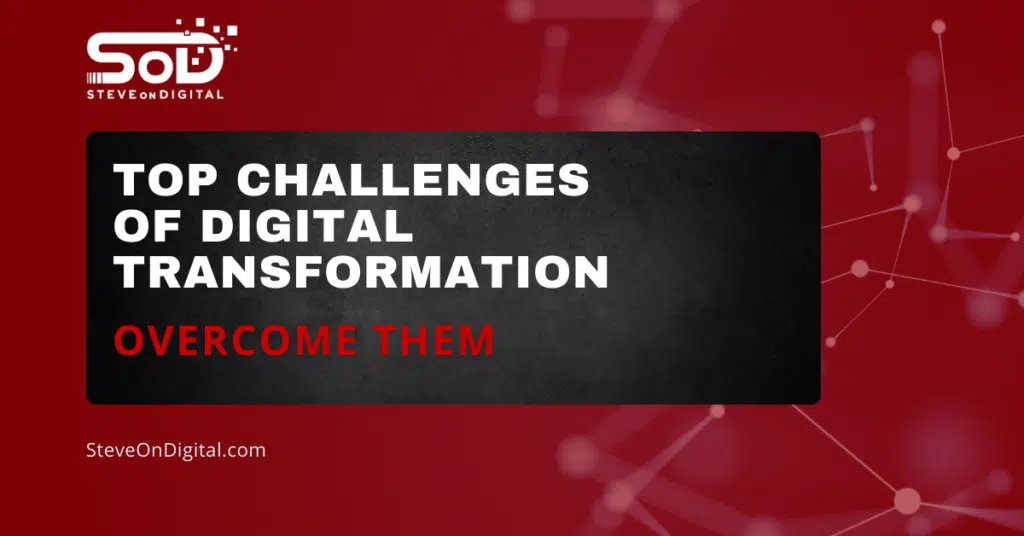Top Challenges Of Digital Transformation And How To Overcome Them

Digital transformation means using new digital tools to change how a business works, its culture, and how it interacts with customers. This transformation can face many challenges, including legacy systems, change management issues, and a digital skills gap. These obstacles can slow down progress and make it difficult to fully leverage the digital processes and technologies. In today’s competitive environment, with digital transformation difficult, understanding these challenges is crucial for success. Addressing these issues can help businesses streamline operations, enhance customer experiences, and stay ahead in the market. Through careful planning and strategy, companies can overcome these hurdles and achieve a successful digital transformation. I’m Steve, a digital transformation expert with a strong background in electrical engineering, an MBA, and a master’s in Project Management. I excel at helping SMEs navigate the new digital solutions landscape with practical insights. Let’s begin! Understanding Digital Transformation What Is Digital Transformation? Digital transformation means using digital tools to change how businesses work, improve company culture, and enhance customer experiences to stay up-to-date with market needs. It involves rethinking business in the digital world. The Digital Transformation Journey Every business’s digital transformation journey is unique, but it typically includes the following stages: Stage Description Awareness and Vision Recognizing the need for digital transformation and setting clear goals. Evaluation and Planning Assessing current capabilities and planning the transformation strategy. Execution and Implementation Deploying new technologies and processes. Optimization Continuously improving and adapting to new digital advancements. Digital Transformation Process The digital transformation process involves several key steps: Key Challenges of Digital Transformation Challenge Description Strategy Legacy Systems Outdated technologies incompatible with new technologies, leading to high maintenance costs. Consider phased upgrades or migrations to modern platforms. Change Management Strategy Overcoming resistance and ensuring a smooth transition through communication, training, and support. Engage stakeholders early, provide clear communication, and offer training programs. Digital Skills Gap Shortage of professionals with necessary digital skills, slowing down transformation efforts. Invest in training and development programs, collaborate with educational institutions, and consider outsourcing or partnerships. Legacy Systems Outdated technologies and systems, often referred to as legacy systems, can significantly hinder digital transformation efforts. These systems are typically incompatible with new technologies, leading to integration issues and high maintenance costs. Upgrading or replacing these systems is often necessary but can be complex and costly (Exploding Topics) (Digital Adoption). Change Management Strategy Effective and thorough change management strategy is critical to overcoming resistance and ensuring a smooth transition. This involves: Digital Skills Gap There is a significant shortage of professionals with the necessary digital skills. This skills gap can slow down transformation efforts and affect the implementation of new technologies. Investing in training and development is crucial to bridging this digital skill gap, and ensuring a successful transformation (Exploding Topics) (Digital Adoption). Data and Statistics Metric Statistic Global Spending Projection Expected to reach $3.4 trillion by 2026 Pandemic Acceleration Accelerated initiatives by an average of six years AI and Cloud Adoption 45% scaling up cloud capabilities, 39% investing in AI Leadership Involvement 72% of data and analytics leaders involved in transformation efforts Overcoming Digital Transformation Challenges Developing Digital Skills Bridging the digital skills gap is crucial for any organization’s digital transformation journey. Many organizations face this challenge due to the rapid pace of technological advancements. To address this, I recommend the following strategies for looming digital skill gap: Strategy Description Invest in Training Programs Ongoing training and upskilling opportunities for employees. Leverage Online Learning Platforms Using platforms like Coursera, Udemy, and LinkedIn Learning for digital skills courses. Partner with Educational Institutions Collaborating with universities and technical schools for tailored programs. A study found that 87% of organizations recognize that upskilling their employees is necessary to stay competitive (Exploding Topics). Implementing Change Management Effective change management is essential to reduce resistance and ensure a smooth and seamless transition to transition during digital transformation. Practice Description Clear Communication Clearly communicate the vision and benefits of digital transformation to all employees. Employee Involvement Involve employees in the planning and implementation process to increase buy-in and reduce resistance. Provide Support and Resources Offer training, resources, and support to help employees adapt to new technologies and processes. Here are some best practices: Statistics show that 70% of change programs fail due to employee resistance and lack of management support (Whatfix). Upgrading Legacy Systems Modernizing or replacing outdated systems is a significant challenge in digital transformation. Here are some approaches: According to recent data, 56% of organizations cite upgrading obsolete IT infrastructure as a top reason for increased IT budgets (Exploding Topics). Digital Transformation Initiatives Planning Digital Initiatives Effective planning is key to the success of digital transformation initiatives. Here are the steps: Data shows that 64% of organizations believe they need to build new digital businesses to stay competitive (Exploding Topics). Implementing Digital Solutions Deploying new digital tools and technologies effectively requires a structured approach: Statistics indicate that 45% of small and medium businesses encounter budget limitations as a major challenge in executing digital strategies (DOIT). Monitoring Digital Transformation Programs Tracking and measuring the success of digital transformation initiatives is crucial. Here’s how to do it effectively: Studies show that organizations with effective monitoring strategies prioritize digital investments are more likely to achieve successful digital transformation (Whatfix). Technological Challenges Integration of New Technologies Integrating new technologies with existing systems can be challenging. Here are some tips: Research indicates that 84% of organizations are exploring or using AI and machine learning for digital-first business (DOIT). Technology Procurement Plans and Budgets Managing technology procurement and budgets effectively is essential. Consider the following: Data shows that 51% of digital transformation efforts arise from growth opportunities and increased competitive pressure (Whatfix). Maintaining Secure Digital Transformation Security is a critical concern during digital transformation. Here’s how to implement effective security measures: According to recent statistics, 95% of organizations believe that digital transformation leads to higher efficiency in tackling challenges (Exploding Topics). Cultural and Organizational Challenges Risk-Averse Organizational Culture A conservative corporate culture can significantly hinder digital transformation. Many businesses are wary

